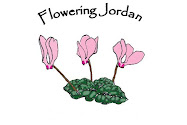Before we made our
trip to London's National Gallery in December, Artist Son asked his art teacher for advice as to how he should approach a gallery trip. She advised him to pick a few pieces that he especially liked, study them, and try to sketch them.
Artist Son's imagination was captured by the beautiful realism of Michelangelo Caravaggio's work, and he spent more time gazing at his
Supper at Emmaus (based on Luke 24) than he did any other painting in the gallery. He began a sketch, but it was hard to work on as there was a near constant stream of viewers moving before this famous painting.
 Supper at EmmausMichelangelo Merisi da Caravaggio1601
Supper at EmmausMichelangelo Merisi da Caravaggio1601
The National GalleryDoes it remind you of another famous painting? DiVinci's
The Last Supper perhaps? It did, me: Jesus in the center, eyes on him, breaking of bread, dramatic hand gestures. A striking difference, however, is the way in which Caravaggio's scene comes alive as he has so brilliantly captured the recognition of Christ.
Here is another analysis of the painting that I enjoyed.
A short artist sketch on Caravaggio, by Artist Son
Michelangelo Merisi da Caravaggio stands out in history as a revolutionary artist because of his uncompromising quest for truth. Caravaggio can be classified as a naturalist because he aims to present not an idealized or beautified picture of the world, but rather to depict the world as it really is. Caravaggio was not afraid of ugliness, but neither was he abrasive enough to praise it for its own sake. Instead, his intention was to faithfully copy nature , whether the viewer thought it ugly or beautiful.
Caravaggio’s works center around religious themes and events. The style with which he portrayed those holy events was without precedent and his contemporaries were often repulsed by their “unconventionality”. Yet, none of his critics’ remarks so much as moved him. He worked tirelessly to remove the barrier of time dividing the ancient events from the present and used every means he could to make the holy events come alive. He often used his friends and acquaintances, common lay-people as models. He rarely worked off sketches but preferred to work in an organic fashion – finding the shapes and forms with paint. Perhaps this method removed the stiffness or flatness of his figures and enhanced the impression of a believable three dimensional world. At any rate, this method allowed him to produce work after work in rapid succession, much quicker than many other artists. Also, instead of manipulating light to suffuse his scene with a pleasant glow as the classical painters did, he treated it with honesty, often fostering sharp contrast between light and shadow. All this he did to create dramatic representations that would arrest his viewers with their boldness and lifelike quality.
And a few more words on Caravaggio's realism, from Artist Son, lifted from a persuasive speech he gave against sentimentalism in art and using Caravaggio's painting,
Doubting Thomas as an example:
 Doubting Thomas
Doubting ThomasMichelangelo Merisi da Caravaggio
1602-1603
Sanssouci, Potsdam
Artists of the past can provide present day artists with examples of how this* is done. Caravaggio, a Catholic artist who lived a very dark and pained existence knew firsthand the potency of evil. His work shows that. In the painting above, the viewer is boldly confronted with a disturbing image: doubting Thomas having his finger thrust into the wound in Christ’s side. In fact, by the graphic portrayal of light, the huge proportions of the figures when compared to the frame, and the intensity and concentration in the moment, the viewer finds himself a part of the scene. We cringe when we look at Thomas’ finger sticking into Christ’s side. We feel the flesh. What’s more, we can’t ignore it because Christ is firmly clasping our wrist and leading our finger into his side. This is a painting that reveals the unveiled effects of sin.
*Thesis:
Knowing that “sentimentalism resents evil instead of fighting it” (Douglas Wilson) the church should make an effort to encourage art that demonstrates evil as real and dangerous, and must be actively fought against, not ignored.


 Pretty though they were, with their aubergine colored immature fruits, the hypodermic needle-like hairs on their leaves gave them away, and one slight accidental brush against a leaf in the process of photographing them confirmed my identification. Definitely, stinging nettles.
Pretty though they were, with their aubergine colored immature fruits, the hypodermic needle-like hairs on their leaves gave them away, and one slight accidental brush against a leaf in the process of photographing them confirmed my identification. Definitely, stinging nettles. While I search ground for signs of flora life, Dear Husband and Tatya's eyes searched for potter sherds. Dear Husband showed Tayta how to tell the difference between pottery that was fired in a hot vs a not-so-hot oven: the pottery fired at a lower temperature a core layer of pottery which is a different color than the terracotta exterior (shown above).
While I search ground for signs of flora life, Dear Husband and Tatya's eyes searched for potter sherds. Dear Husband showed Tayta how to tell the difference between pottery that was fired in a hot vs a not-so-hot oven: the pottery fired at a lower temperature a core layer of pottery which is a different color than the terracotta exterior (shown above).











